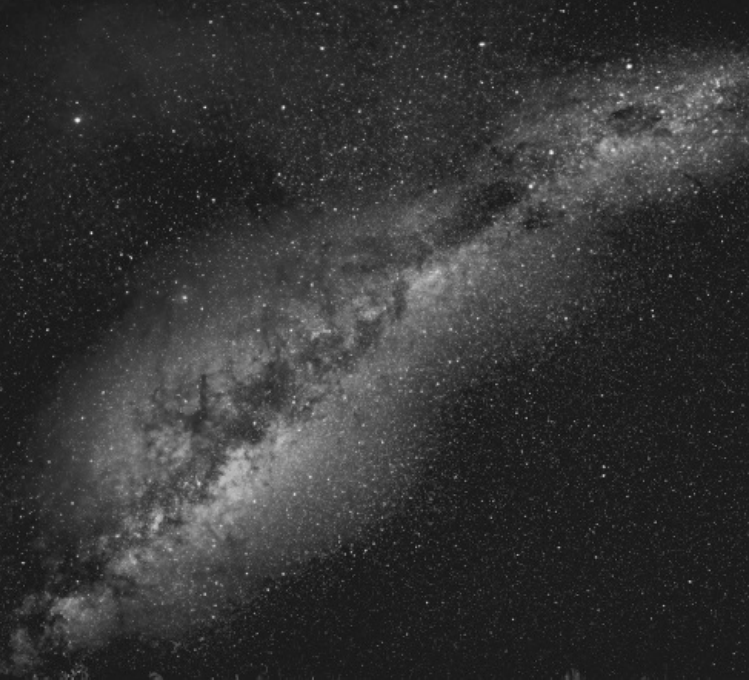The Celestial Emu – Gawarrgay
REGION
Aboriginal Australia,
Gamilaraay
Aboriginal Australia,
Gamilaraay
OBJECT
Milky Way
Milky Way
SOURCE
Adapted from Karlie Noon and Krystal De Napoli, “First Knowledges Astronomy: Sky Country” (Australia: Thames and Hudson, 2022) and Gullberg, S. R., Hamacher, D. W., Martín-Lopez, A., Mejuto, J., Munro, A. M., and Orchiston, W., “A cultural comparison of the 'dark constellations' in the Milky Way”, Journal of Astronomical History and Heritage, vol. 23, no. 2, pp. 390–404, 2020.
Adapted from Karlie Noon and Krystal De Napoli, “First Knowledges Astronomy: Sky Country” (Australia: Thames and Hudson, 2022) and Gullberg, S. R., Hamacher, D. W., Martín-Lopez, A., Mejuto, J., Munro, A. M., and Orchiston, W., “A cultural comparison of the 'dark constellations' in the Milky Way”, Journal of Astronomical History and Heritage, vol. 23, no. 2, pp. 390–404, 2020.


In ancient times, humans looked to the dark starry sky and saw a ghostly band of light arcing from horizon to horizon. This graceful arc of light moved across the sky with the seasons. The most casual sky-watchers would notice that darkness obscured parts of the band, which are now known to be vast clouds of dust.
Different peoples see various creatures or places emerge from these features, each with its own meaning. To some, it is a big rip across the sky. To astronomers, it’s an entire galaxy shrouded by space clouds, behind which hides a supermassive black hole. To the ancient Armenians, it was straw strewn across the sky by the god Vahagn. In eastern Asia, it was the Silvery River of Heaven. The Finns and Estonians saw it as the Pathway of the Birds. The Greeks and the Romans saw the starry band as a river of milk. In Aboriginal Australia, the Wardaman people of the Northern Territory see it as the Rainbow Serpent, accompanied by the Sky Boss and Earth Lady. The Yolŋu people of north-east Arnhem Land see a crow, and in the western Torres Strait, a shovel-nosed shark.
For many Aboriginal nations, from east coast to west and from the Top End to the south, it is the Dark Emu, sometimes referred to as the Celestial Emu. In Gamilaraay, ‘Gawarrgay’ refers to the featherless, ceremonial Celestial Emu and ‘dhinawan’ refers to the land-dwelling, flightless bird. It is of particular importance to the Gamilaraay/Kamilaroi people as the dhinawan is their totem. It connects the dhinawan’s breeding cycle and its movement across Country, mirroring the movements of Gawarrgay across the sky.
In the months of April and May, Gawarrgay is seen as a female emu running, chasing a male emu to mate. At the same time, on the land, the female dhinawan are chasing the males for breeding. After May, the dhinawan’s gawu (eggs) appear. This is the best time for gawu to be collected, but people should only take what they need and leave the rest. If they wait too long in the season, the burrgay (emu chicks) form in the gawu. People should not disturb these gawu as the new generation of dhinawan is taking shape.
In the winter, Gawarrgay’s legs disappear as he dives toward the horizon, indicating that the male dhinawan is sitting on the gawu on the land. It signals to the Gamilaraay people to stop hunting as the eggs are now in incubation.
As the year progresses, Gawarrgay changes form and appears as a featherless emu. Finally, in November, only the body of Gawarrgay remains, signalling that the dhinawan are currently occupying waterholes. Gawarrgay’s shortened form signifies to the Gamilaraay people to move across Country to access the same reservoirs as the dhinawan, but also to protect them from being overused and destroyed by the thirsty, cheeky dhinawan.
When Gawarrgay reappears in February, people start moving from their summer camps and the waterholes to their winter camps. Just a few months later, the annual cycle of Gawarrgay, the dhinawan and the Gamilaraay people repeats.
Related:
In central Brazil, Tupi astronomers see a very similar bird-shaped dark sky constellation in the Milky Way. The shape represents their native bird, the rhea. Coincidentally, the rhea is not only also a large flightless bird, it shares a similar breeding cycle to the emu. Like Gawarrgay, the celestial rhea’s head is also made up by the pool of darkness that is the Coalsack Nebula, with the stars of the Southern Cross described as holding the head of this enormous celestial beast in place lest it break free and guzzle up all of the world’s water.